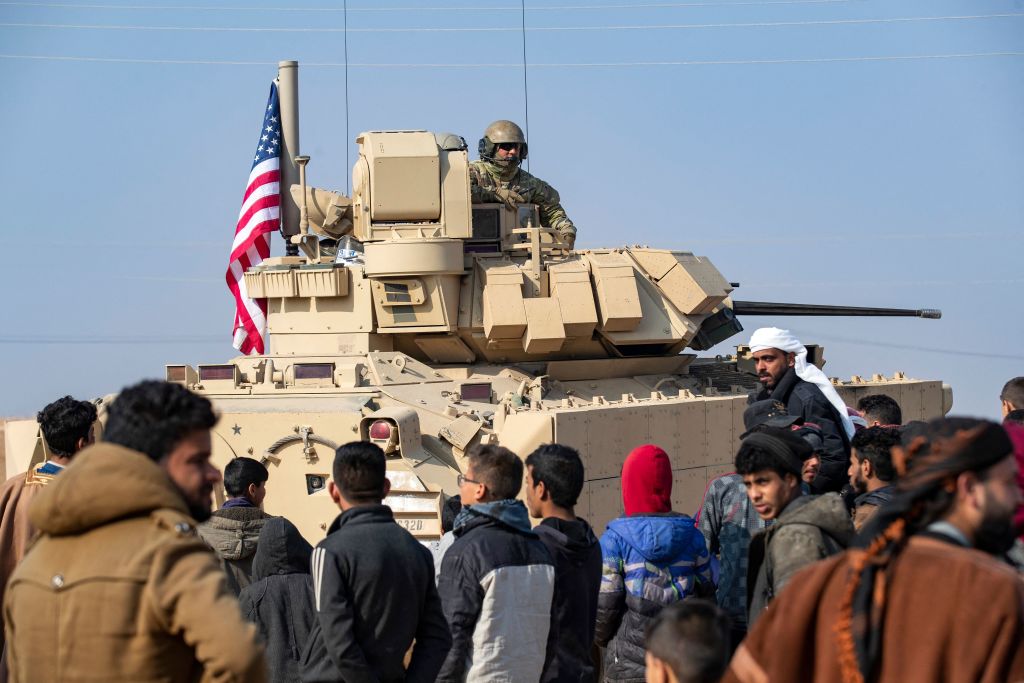As the Biden administration tries to avoid being drawn into the conflict in Ukraine, Russia’s reliance on Iran for assistance in its invasion has given the Islamic Republic bargaining power over Moscow and increases the danger of head-to-head conflict in an entirely different theater: Syria.
A recent tranche of documents from the Discord leaks—classified material shared online by a 21-year-old Massachusetts Air National Guard airman this year—outline a coordinated plan by Russia, Iran, and Syria to rid the country of its U.S. military presence.
The U.S. first intervened to fight the Islamic State at the height of the Syrian civil war and now retains a military footprint of some 900 troops—along with hundreds of contractors and advanced weapons systems—to prevent the terrorist group from regrouping. In 2019, for example, Islamic State leader Abu Bakr al-Baghdadi died during a U.S. raid of a compound in northwestern Syria. But the continued American troop presence has another goal: countering Iranian and Russian influence in the country and keeping in line their ally, Syrian President Bashar al-Assad.
According to the leaked reports, first reported by the Washington Post, Iran has been arming and training local fighters to use powerful roadside explosives against American armored vehicles on the ground. The remotely detonated bombs, reportedly capable of piercing even tanks, could result in mounting American casualties and lead to inadvertent escalation.
The report demonstrates “the Islamic Republic’s increased leverage over Moscow in the aftermath of its invasion of Ukraine and its dependence on Iran for arms, particularly drones, in its war,” Jason Brodsky, policy director for United Against Nuclear Iran, tells The Dispatch. “Russia having a more permissive attitude for the Islamic Republic to escalate in Syria is something that the U.S. and Israeli governments have been eyeing for some time.”
And as Iranian proxies threaten U.S. forces from the ground, Russia threatens them from the sky. Since March, CENTCOM commander Gen. Michael “Erik” Kurilla recently told Congress, there has been a “significant spike” in Russian pilots flying warplanes over U.S. bases in Syria. What’s more—the aircraft have been armed with weapons capable of targeting American troops and equipment on the ground.
The Russian pilots are equipped with “air-to-ground munitions on board, very close to our locations on the ground,” Lt. Gen. Alexus Grynkewich, commander of all U.S. Air Force units in the Middle East, said during a CENTCOM podcast released last week. “I think they’re intentionally trying to pressure the United States, and make us worry about the stability of our presence in the region.”
The recent escalations threaten to derail the delicate balance struck by the foreign powers operating in Syria. Like the U.S., Iran and Russia intervened in Syria during its civil war, with the former sending ground troops and the latter providing air support to shore up the Assad regime. Both have stuck around since, but recent reports signal a new, more organized phase in their efforts to rid the country of its U.S. presence.
Last month the Long War Journal reported that Lebanese Hezbollah’s “Golan Unit,” a branch of the Iranian-backed group operating in southern Syria, had been preparing for an attack against American soldiers at a training center not far from Damascus. The unit’s reported commander, Ali Mussa Daqduq, is a U.S.-designated terrorist who has been linked to attacks on U.S. troops in Iraq.
Meanwhile, Iran has been strengthening its defensive position in eastern Syria, according to a report published by the American Enterprise Institute’s Critical Threats Project last week. In addition to transferring air defenses and precision guided munitions to militias in the eastern Deir ez Zor Province, Iran is sending specialists to train fighters on the new equipment. These advanced arms will help Iran keep open a transit route through which to funnel weapons and supplies to its regional proxies.
This flow of arms poses a threat to U.S. military personnel, but also to nearby Israel and the Syrian Democratic Forces (SDF)—a Kurdish militia in control of northeast Syria and the primary U.S. ally in the country.
In SDF-controlled Hasakah in March, an attack using a suspected Iranian drone killed one American contractor and wounded five U.S. service members and another contractor on a coalition base. The U.S. responded with airstrikes, killing four Iranian-backed fighters, but analysts say Iran’s motivation is unlikely to wane so long as American retaliation targets only its proxy groups.
“The U.S. has only been retaliating against the proxies of the Islamic Republic, not the Islamic Republic itself. And the proxies are disposable,” says Brodsky. “The Iranians will fight to every last Syrian, Lebanese, and Iraqi, but when it comes to suffering an attack on one of their assets, they are more risk averse. So we have a deterrence issue in Syria.”







Please note that we at The Dispatch hold ourselves, our work, and our commenters to a higher standard than other places on the internet. We welcome comments that foster genuine debate or discussion—including comments critical of us or our work—but responses that include ad hominem attacks on fellow Dispatch members or are intended to stoke fear and anger may be moderated.
With your membership, you only have the ability to comment on The Morning Dispatch articles. Consider upgrading to join the conversation everywhere.